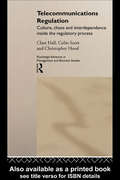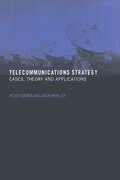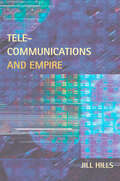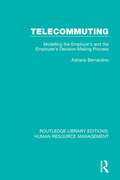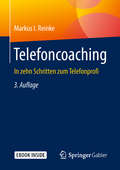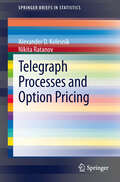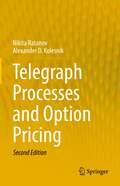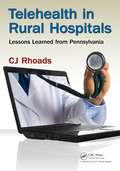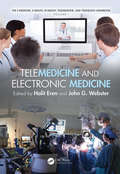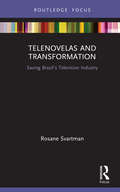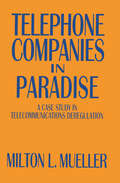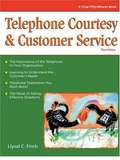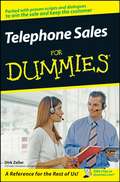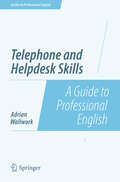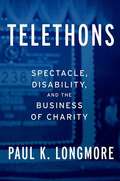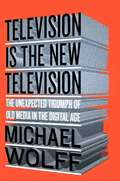- Table View
- List View
Telecommunications Regulation: Culture, Chaos and Interdependence Inside the Regulatory Process (Routledge Advances in Management and Business Studies)
by Christopher Hood Colin Scott Clare HallUsing unprecedented access to the key actors inside the UK Office of Telecommunications (OFTEL) and supporting interviews, this book explores how telecommunications regulation works from the inside.
Telecommunications Strategy: Cases, Theory and Applications
by Peter Curwen Jason WhalleyThe telecommunications industry is one of the most influential and significant global industries. As well as being fundamentally important to the health of the modern economy, it is going through a period of unprecedented change, facing a range of strategic challenges from globalization and cross-border alliances, to changing technologies and consu
Telecommunications and Empire (The History of Media and Communication)
by Jill HillsJill Hills picks up from her pathbreaking study The Struggle for Control of Global Communication: The Formative Century to continue her examination of the political, technological, and economic forces at work in the global telecommunications market from World War II to the World Trade Organization agreement of 1997. In the late twentieth century, focus shifted from the creation and development of global communication markets to their intense regulation. The historical framework behind this control--where the market was regulated, by what institution, controlled by what power, and to whose benefit--masterfully complements Hills's analysis of power relations within the global communications arena. Hills documents attempts by governments to direct, replace, and bypass international telecommunications institutions. As she shows, the results have offered indirect control over foreign domestic markets, government management of private corporations, and government protection of its own domestic communication market. Hills reveals that the motivation behind these powerful, regulatory efforts on person-to-person communication lies in the unmatched importance of communication in the world economy. As ownership of communications infrastructure becomes more valuable, governments have scrambled to shape international guidelines. Hills provides insight into struggles between U.S. policymakers and the rest of the world, illustrating the conflict between a growing telecommunications empire and sovereign states that are free to implement policy changes. Freshly detailing the interplay between U.S. federal regulation and economic power, Hills fosters a deep understanding of contemporary systems of power in global communications.
Telecommuting: Modelling the Employer's and the Employee's Decision-Making Process (Routledge Library Editions: Human Resource Management)
by Adriana BernardinoTelecommuting has been regarded as a powerful tool to reduce traffic congestion, pollution and energy consumption. It also supposed to improve lifestyle quality and job satisfaction by providing employees with flexible schedules with which to address their work load and personal requirements whilst also enhancing recruitment capability and productivity and significantly reducing costs. Nevertheless, a strong resistance to the adoption of telecommuting still persists. In this book, first published in 1996, state of the art demand modelling techniques are used to delve into critical issues raised by the question of telecommuting. The benefits and costs of telecommuting are investigated in an effort to provide concrete evidence to inform the private sector’s adoption decision process and the public sector’s policy design. This title will be of interest to students of business studies and human resource management.
Telecosm: How Infinite Bandwidth Will Revolutionize Our World
by George GilderThe computer age is over. After a cataclysmic global run of thirty years, it has given birth to the age of the telecosm -- the world enabled and defined by new communications technology. Chips and software will continue to make great contributions to our lives, but the action is elsewhere. To seek the key to great wealth and to understand the bewildering ways that high tech is restructuring our lives, look not to chip speed but to communication power, or bandwidth. Bandwidth is exploding, and its abundance is the most important social and economic fact of our time. George Gilder is one of the great technological visionaries, and "the man who put the 's' in 'telecosm'" (Telephony magazine). He is equally famous for understanding and predicting the nuts and bolts of complex technologies, and for putting it all together in a soaring view of why things change, and what it means for our daily lives. His track record of futurist predictions is one of the best, often proving to be right even when initially opposed by mighty corporations and governments. He foresaw the power of fiber and wireless optics, the decline of the telephone regime, and the explosion of handheld computers, among many trends. His list of favored companies outpaced even the soaring Nasdaq in 1999 by more than double. His long-awaited Telecosm is a bible of the new age of communications. Equal parts science story, business history, social analysis, and prediction, it is the one book you need to make sense of the titanic changes underway in our lives. Whether you surf the net constantly or not at all, whether you live on your cell phone or hate it for its invasion of private life, you need this book. It has been less than two decades since the introduction of the IBM personal computer, and yet the enormous changes wrought in our lives by the computer will pale beside the changes of the telecosm. Gilder explains why computers will "empty out," with their components migrating to the net; why hundreds of low-flying satellites will enable hand-held computers and communicators to become ubiquitous; why television will die; why newspapers and magazines will revive; why advertising will become less obnoxious; and why companies will never be able to waste your time again. Along the way you will meet the movers and shakers who have made the telecosm possible. From Charles Townes and Gordon Gould, who invented the laser, to the story of JDS Uniphase, "the Intel of the Telecosm," to the birthing of fiberless optics pioneer TeraBeam, here are the inventors and entrepreneurs who will be hailed as the next Edison or Gates. From hardware to software to chips to storage, here are the technologies that will soon be as basic as the air we breathe.
Telefoncoaching: In Zehn Schritten Zum Telefonprofi
by Markus I. ReinkeDas Telefon ist Kontaktmedium Nummer 1 im B2B-Bereich. Für die meisten Unternehmen stellt es das wichtigste Instrument in der Kundenkommunikation und in der aktiven Neukundengewinnung dar. Doch viele Mitarbeiter sind beim Einsatz des Telefons als Verkaufsinstrument unerfahren und unsicher. „Telefoncoaching“ bietet ein praxiserprobtes 10-Stufen-Konzept, mit dem es gelingt, Verkaufserfolge zu vervielfältigen. Neben konkreten Anleitungen enthält das Buch hilfreiche Gesprächsleitfäden, wertvolle Anregungen sowie zahlreiche Checklisten und Beispiele für die Anwendung in der Praxis. Zudem: Bewährte Strategien, um Kundeneinwände spielerisch zu überwinden, Tipps zur professionellen Reklamationsbehandlung und besonders wirksame Gesprächseinstiege für die Neukundenakquise. Die dritte Auflage wurde um spezielle Strategien für Fortgeschrittene ergänzt. Unverzichtbar für alle im Vertrieb, die das Telefon regelmäßig zum Kundenkontakt einsetzen.
Telegraph Messenger Boys: Labor, Technology, and Geography, 1850-1950
by Gregory J. DowneyThough providing a perspective on the telegraph system, a communications network that revolutionized human perceptions of time and space, this text's ramifications go far beyond just the telegraphy - it tells a broader story of human interaction with technology, and the social and cultural changes brought about by this interaction.
Telegraph Processes and Option Pricing
by Alexander D. Kolesnik Nikita RatanovThe telegraph process is a useful mathematical model for describing the stochastic motion of a particle that moves with finite speed on the real line and alternates between two possible directions of motion at random time instants. That is why it can be considered as the finite-velocity counterpart of the classical Einstein-Smoluchowski's model of the Brownian motion in which the infinite speed of motion and the infinite intensity of the alternating directions are assumed. The book will be interesting to specialists in the area of diffusion processes with finite speed of propagation and in financial modelling. It will also be useful for students and postgraduates who are taking their first steps in these intriguing and attractive fields.
Telegraph Processes and Option Pricing
by Alexander D. Kolesnik Nikita RatanovThis book provides an extensive, systematic overview of the modern theory of telegraph processes and their multidimensional counterparts, together with numerous fruitful applications in financial modelling. Focusing on stochastic processes of bounded variation instead of classical diffusion, or more generally, Lévy processes, has two obvious benefits. First, the mathematical technique is much simpler, which helps to concentrate on the key problems of stochastic analysis and applications, including financial market modelling. Second, this approach overcomes some shortcomings of the (parabolic) nature of classical diffusions that contradict physical intuition, such as infinite propagation velocity and infinite total variation of paths. In this second edition, some sections of the previous text are included without any changes, while most others have been expanded and significantly revised. These are supplemented by predominantly new results concerning piecewise linear processes with arbitrary sequences of velocities, jump amplitudes, and switching intensities. The chapter on functionals of the telegraph process has been significantly expanded by adding sections on exponential functionals, telegraph meanders and running extrema, the times of the first passages of telegraph processes with alternating random jumps, and distribution of the Euclidean distance between two independent telegraph processes. A new chapter on the multidimensional counterparts of the telegraph processes is also included. The book is intended for graduate students in mathematics, probability, statistics and quantitative finance, and for researchers working at academic institutions, in industry and engineering. It can also be used by university lecturers and professionals in various applied areas.
Telehealth and Mobile Health
by John G. Webster Halit ErenThe E-Medicine, E-Health, M-Health, Telemedicine, and Telehealth Handbook provides extensive coverage of modern telecommunication in the medical industry, from sensors on and within the body to electronic medical records and beyond. Telehealth and Mobile Health is the second volume of this handbook. Featuring chapters written by leading experts and
Telehealth in Rural Hospitals: Lessons Learned from Pennsylvania
by CJ RhoadsImproving the quality of healthcare, while increasing accessibility and lowering costs, is a complex dilemma facing rural communities around the world. The Center for Rural Pennsylvania believed that telehealth, the use of electronic information and telecommunications technologies to support long-distance clinical healthcare was a viable solution so it recently provided grants to conduct a thorough investigation into the factors involved.Telehealth in Rural Hospitals: Lessons Learned from Pennsylvania reports the outcome of this year-long investigation. Illustrating telehealth implementations in rural settings, it supplies an overview of telehealth as well as an assessment of its economic impact.The book skillfully intertwines the research and academic aspects of telehealth with helpful insights from the author. One of the most important discoveries made by the author and her team of researchers is that all too often money is wasted by implementing telehealth for services that don't impact many people. This book shares valuable insights on using telehealth for integrative health practices that could improve the health of a greater portion of the population.This book illustrates how telehealth can, indeed, be the healthcare savior that some people believe it will be, but only under the right circumstances. It details exactly what those circumstances are so that everyone, including clinicians, patients, government entities, and vendors, can steer toward the best future path.The author identifies the obstacles preventing wider implementation of telehealth and explains how recent federal legislation will affect telehealth implementation in rural communities. She also points out the folly of developing electronic health records before federal data standards are put into place.
Telemarketing experto: Cómo conseguir reuniones para ventas rápidamente
by Bernard Levine Víctor Manuel Mérida JiménezSi lo que quiere es llenar tu agenda con reuniones de ventas, este libro único le ofrecerá resultados rápidos garantizados.
Telemarketing per (aspiranti) esperti
by Bernard Levine Luca TinnirelloSe volete riempire le vostre agende con appuntamenti di vendita, questo libro vi aiuterà a ottenere risultati rapidi e garantiti.
Telemedicine and Electronic Medicine
by Halit Eren and John G. WebsterThe E-Medicine, E-Health, M-Health, Telemedicine, and Telehealth Handbook provides extensive coverage of modern telecommunication in the medical industry, from sensors on and within the body to electronic medical records and beyond. Telemedicine and Electronic Medicine is the first volume of this handbook. Featuring chapters written by leading experts and researchers in their respective fields, this volume: Describes the integration of—and interactions between—modern eMedicine, telemedicine, eHealth, and telehealth practices Explains how medical information flows through wireless technologies and networks, emphasizing fast-deploying wireless body area networks Presents the latest developments in sensors, devices, and implantables, from medical sensors for mobile communication devices to drug-delivery systems Illustrates practical telemedicine applications in telecardiology, teleradiology, teledermatology, teleaudiology, teleoncology, acute care telemedicine, and more The E-Medicine, E-Health, M-Health, Telemedicine, and Telehealth Handbook bridges the gap between scientists, engineers, and medical professionals by creating synergy in the related fields of biomedical engineering, information and communication technology, business, and healthcare.
Telenovelas and Transformation: Saving Brazil’s Television Industry (Routledge Advances in Transmedia Studies)
by Rosane SvartmanThis book investigates how telenovelas may be the key to the future of Brazilian television and how this content can survive in an interconnected media landscape. Recognised telenovela writer and scholar Rosane Svartman considers the particular characteristics of the telenovela format – number of episodes, melodrama influence, and influence of the audience on future writing – to explore how these can be preserved on multimedia platforms, and the challenges this change may present. Svartman further charts the transformations of the telenovela throughout its history and its major influences and unveils the main storytelling elements and writing processes. Chapters examine the business model of Brazilian corporate television within the current context of hypermedia and analyse how this relationship evolves as it is influenced by the new interactive tools and technologies that amplify the audience’s power. Merging empirical practices and theory, this book will be of great interest to scholars and students of transmedia storytelling, television studies, and Latin American media, as well as professionals working in these areas.
Telepass: From Tolling to Mobility Platform
by Sarah Mehta Chiara Farronato Stefano DenicolaiTelepass, until very recently the sole processor of electronic toll payments on Italy's highways, has ambitions beyond tolling. Since the mid-2010s, the company has been expanding into adjacent services. In 2017, Telepass launched TelepassPay-a mobile payment application (app) that allows subscribers to pay for dozens of mobility-related services and products from their smartphones. In 2019, Telepass launched a car insurance brokerage service. Using Telepass data, the brokerage service offers tailored insurance products to existing customers on behalf of insurance companies for a commission on converted leads. Now, in September 2020, Telepass's senior leaders are considering a new, insurance-related growth opportunity: moving beyond the brokerage model to become the primary insurance seller. It is unclear, however, whether Telepass's data provides sufficient insights into individual drivers' risk profiles to build competitive, customized insurance products. Alternatively, Telepass could continue to improve the brokerage model and focus its resources on adding new mobility services to TelepassPay. This case is paired with a supplementary dataset (courseware no. 622-701), which provides a data analysis opportunity for students.
Telepass: From Tolling to Mobility Platform (Abridged)
by Sarah Mehta Chiara Farronato Stefano DenicolaiTelepass, until very recently the sole processor of electronic toll payments on Italy's highways, has ambitions beyond tolling. Since the mid-2010s, the company has been expanding into adjacent services. In 2017, Telepass launched TelepassPay-a mobile payment application (app) that allows subscribers to pay for dozens of mobility-related services and products from their smartphones. In 2019, Telepass launched a car insurance brokerage service. Using Telepass data, the brokerage service offers tailored insurance products to existing customers on behalf of insurance companies for a commission on converted leads. Now, in September 2020, Telepass's senior leaders are considering a new, insurance-related growth opportunity: moving beyond the brokerage model to become the primary insurance seller. It is unclear, however, whether Telepass's data provides sufficient insights into individual drivers' risk profiles to build competitive, customized insurance products. Alternatively, Telepass could continue to improve the brokerage model and focus its resources on adding new mobility services to TelepassPay. This case is paired with a supplementary dataset (courseware no. 622-701), which provides a data analysis opportunity for students.
Telephone Companies in Paradise: A Case Study in Telecommunications Deregulation
by Milton L. MuellerComputerization has generated dramatic advances In telecommunications, such as mobile telephones and video conferencing. Coupled with this are major changes in regulation, as telephone companies face new competitors. States are experimenting with new forms of utility regulation and deregulation in order to cope with the demands of rising competition. Here Mueller examines in detail the results of a radical telephone regulation law.In 1986, the state of Nebraska completely discarded traditional utility regulation, deregulating rates and profits of its local telephone companies. The Nebraska experiment has become a benchmark for reassessing the role of state regulation In the future of telecommunications. Using comparative data from five midwestern states, Mueller shows how deregulation affected rates, investment, infrastructure modernization, and profits. He uncovers both positive and negative results. Mueller found established telephone companies to be basically conservative, not aggressive and expansionist, and concludes that new competition, not regulation or deregulation, is transforming the telecommunications industry.This book is the first systematic empirical study of the controversial Nebraska law and its broader effects. It will be a significant addition to the much debated issue of telecommunications deregulation. Economists, policymakers, and telecommunications managers will find in this volume a substantial resource. According to Robert Atkinson, senior vice president of Teleport Communications Group: "Nebraska's experiences with telecommunications deregulation - the good, the bad and the ugly - need to be understood by all telecommunications policymakers across the country so that they can emulate Nebraska's successes and avoid its mistakes. Mueller provides the roadmap."
Telephone Courtesy and Customer Service (3rd Edition)
by Lloyd C. FinchGive employees effective telephone skills and you will see what a powerful business tool the phone can be. Everything from voice inflection to follow-up calls is covered in this course. Understand customers' needs. Ask effective questions. Master proper telephone techniques.
Telephone Sales For Dummies
by Dirk ZellerNearly 100 million Americans (one out of three) purchase goods and services over the phone each year. Telephone Sales For Dummies shows both new and seasoned sales reps, from realtors, insurance agents to telemarketers, how to create pre-call plans and effectively prospect via the phone. Packed with techniques, scripts, and dialogues, this hands-on, interactive guide assists readers with making cold calls, warm calls, and referral calls, helping them plan and execute openings to create interesting dialogue; ask key questions; develop persuasive presentation techniques; work within the No Call Law parameters; leave effective and enticing voicemails that get results; get past screeners and get quality referrals; find hot leads; and create callback scripts that close the sale.
Telephone and Helpdesk Skills: A Guide to Professional English (Guides to Professional English)
by Adrian WallworkIf you are a non-native English speaker and make telephone calls as part of your work, then this book is for you. By applying the suggested guidelines, you will stand a much greater chance of making an effective telephone call. You will learn how to:prepare for a call both psychologically and from an English language point of viewreceive calls (if you work on reception)leave messagesfind out about another company and talk about your own companychase people (i.e. people who have not followed up your requests)deal with difficult calls and callers, and improve your telephone manneruse the telephone while working on a help desk or helplineresolve language difficulties (i.e. when you cannot understand the other person's English)improve your pronunciationuse resources on the Internet to improve your listening skillsThe book concludes with a chapter of useful phrases. There is a brief introduction for trainers on how to teach telephone and helpdesk skills within a Business English course.
Teleswitch (A)
by Michael J. RobertsDescribes the financing history of Teleswitch, a maker of small digital telephone switches for the wireless/cellular industry. As the case ends, Teleswitch is revisiting its selection of an investment banker for its hoped-for IPO. A rewritten version of an earlier case.
Teleswitch (B)
by Michael J. RobertsSupplements the (A) case. A rewritten version of an earlier case.
Telethons: Spectacle, Disability, And The Business Of Charity
by Paul K. LongmoreMovie stars, entertainers, game-show hosts, jugglers, plate-spinners, gospel choirs, corporate executives posing with over-sized checks, household name-brand products, smiling children in leg braces-all were fixtures of the phenomenon that defined American culture in the second half of the twentieth century: the telethon. Hundreds of millions watched these weekend-long variety shows that raised billions of dollars for disability-related charities. Drawing on over two decades of in-depth research, Telethons trenchantly explores the complexity underneath the campy spectacles. At its center are the disabled children, who, thanks to a particular kind of historical-cultural marginalization, turned out to be ideal tools for promoting corporate interests, privatized healthcare, and class status. Offering a public message about helping these unfortunate victims, telethons perpetuated a misleading image of people with disabilities as helpless, passive, apolitical members of American society. Paul K. Longmore's revelatory chronicle shows how these images in fact helped major corporations increase their bottom lines, while filling gaps in the strange public-private hybrid U. S. health insurance system. Only once disabled people pushed back in public protests did the broader implications for all Americans become clear. Mining insights from great thinkers such as Adam Smith, Edmund Burke, and Alexis de Tocqueville, along with contemporary cultural figures like Jerry Lewis, Ralph Nader, and several disability rights activists, Telethons offers a provocative meditation on big business, American government, popular culture, Cold War values, and "activism" both narrowly and broadly defined. As highly popular entertainment, telethons schooled Americans about how to feel about their bodies, fitness, health, and appropriate ways to interact with people whose bodies did not fit norms determined by advertisers. The programs also taught them about when to weep and how to cure guilt through "conspicuous contribution. " Longmore's astute observations about psychology, economics, and society reveal how writing off telethons as kitsch and irrelevant has enabled many individual attitudes, corporate practices, and government policies to go unquestioned. Ultimately, Telethons reveals the passion, humanity, resistance, and triumph that were not center-stage on these popular telecasts by offering insights into the U. S. disability movement past and present.
Television Is the New Television
by Michael Wolff"The closer the new media future gets, the further victory appears." --Michael WolffThis is a book about what happens when the smartest people in the room decide something is inevitable, and yet it doesn't come to pass. What happens when omens have been misread, tea leaves misinterpreted, gurus embarrassed?Twenty years after the Netscape IPO, ten years after the birth of YouTube, and five years after the first iPad, the Internet has still not destroyed the giants of old media. CBS, News Corp, Disney, Comcast, Time Warner, and their peers are still alive, kicking, and making big bucks. The New York Times still earns far more from print ads than from digital ads. Super Bowl commercials are more valuable than ever. Banner ad space on Yahoo can be bought for a relative pittance.Sure, the darlings of new media--Buzzfeed, HuffPo, Politico, and many more--keep attracting ever more traffic, in some cases truly phenomenal traffic. But as Michael Wolff shows in this fascinating and sure-to-be-controversial book, their buzz and venture financing rounds are based on assumptions that were wrong from the start, and become more wrong with each passing year. The consequences of this folly are far reaching for anyone who cares about good journalism, enjoys bingeing on Netflix, works with advertising, or plans to have a role in the future of the Internet.Wolff set out to write an honest guide to the changing media landscape, based on a clear-eyed evaluation of who really makes money and how. His conclusion: the Web, social media, and various mobile platforms are not the new television. Television is the new television.We all know that Google and Facebook are thriving by selling online ads--but they're aggregators, not content creators. As major brands conclude that banner ads next to text basically don't work, the value of digital traffic to content-driven sites has plummeted, while the value of a television audience continues to rise. Even if millions now watch television on their phones via their Netflix, Hulu, and HBO GO apps, that doesn't change the balance of power. Television by any other name is the game everybody is trying to win--including outlets like The Wall Street Journal that never used to play the game at all.Drawing on his unparalleled sources in corner offices from Rockefeller Center to Beverly Hills, Wolff tells us what's really going on, which emperors have no clothes, and which supposed geniuses are due for a major fall. Whether he riles you or makes you cheer, his book will change how you think about media, technology, and the way we live now.From the Hardcover edition.
